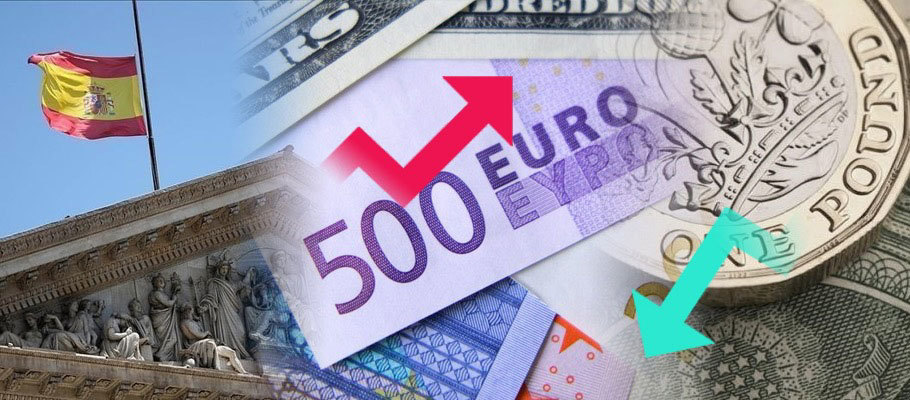
Published: February 1st, 2023
The Euro was up against the Greenback and Pound on Tuesday 31st January after surprise inflation figures from Spain showed an uptick in January. The print had forex traders speculating that a bigger interest rate hike is in the offing from the European Central Bank (ECB).
Spanish inflation rose to 5.7 per cent year-on-year in January 2023, beating the previous month's 5.6 per cent and bulldozing the consensus forecast of 4.9 per cent
The broader inflation measure rose to 5.7 from 5.5 per cent, while core inflation rose 7.5 per cent, according to Spain's official government statistics agency INE.
Spain is often seen as an EUR 'bellwether' that can signal wider trends in Eurozone inflation about two months ahead of formal proclamations by Frankfurt economists. Spain’s latest numbers serve as a warning to the ECB's Governing Council that they’ll need to look again at interest rates.
While they deliberate, money markets wasted no time adding five basis points to forecasts about the ECB’s peak interest rate.
EUR rallied on the news by a third of a percent against Sterling immediately after the release. It rose by 0.20 per cent against the Greenback.
‘Euro yields are up on news that Spain’s inflation rate has accelerated to 5.7 per cent year-on-year in January. We had forecast a drop to 4.7 per cent. Core rose to 7.5 per cent year-on-year,’ said an analyst note from ING Bank in Amsterdam.
'A rise in headline inflation draws a line under five consecutive months of decline while core inflation rocketed up to a new high. This clearly puts paid to the idea that the worst is over for Eurozone inflation. The storm hasn’t passed and the news will only strengthen the resolve of hawks on the ECB’s governing council.’
An INE press release said the increase in headline inflation was primarily due to fuel prices, while post-Christmas clothing and footwear prices fell less than in January of 2022.
Last May, the Euro to Dollar rate (EUR/USD) leapt upward in the wake of the Federal Reserve's decision to raise rates by 50 basis points.
Having leapt to a high of 1.0640, Fed Chair Jerome Powell said no to a more robust 75 basis point rise in July. The pair then settled back to 1.0589 by the following week.
When the Euro is unable to hold onto post-Fed announcement gains, forex traders typically shift focus to downside risks.
In an analyst note, Credit Suisse’s Forex Strategy unit said that ‘we can’t rule out the possibility of moves like EUR/USD falling below parity in the coming months.’
Credit Suisse said it wasn’t a surprise that the Fed didn’t deliver the sort of hawkish pronouncement that might have spurred another serious round of Dollar buying.
But the bank did say the probability of an extended series of rate hikes could ultimately be supportive of USD against EUR.
Credit Suisse economists were watching for two consecutive 50bp hikes to complete the final 200 basis points of hikes they say could arrive through the remainder of 2022, complemented by another 100bp next year. When that approach does occur, it could mean the Fed is being more aggressive than the market.
‘Our view is generally bullish on USD as a result. For us, the fact that the greenback ascended to lofty levels last seen in April 2020 is not a rationale for Dollar negativity.
If anything, the bank said, the risk balance for the pair had shifted to the downside.
‘We can’t completely rule out moves like EUR/USD dipping below parity in the coming months but given the divergence in inflation we still see the direction US rates going higher’.
If last year’s trend is any guide, EUR will continue to move on clues about the coming pace and scale of evolving Frankfurt rate policy.
Last Spring saw the deposit rate rise to well above zero, marking an end to the extended period of negative interest rates, where commercial banks have effectively paid a price for using the ECB as a safe haven for their cash. Bringing that era to an end was a turning point for the Euro to Dollar rate outlook.
ECB Governing Council members had been publicly debating whether or not to raise the benchmark in a standard 0.25 per cent step or by a larger 0.50 per cent increment in July 2022, following the expected end of the ECB’s final QE programme.
FX Analysts at CIBC Capital Markets said in a briefing that ‘inflation is three per cent higher now than it was before the last forecast update. As a result, (ECB Chair Christine) Lagarde may consider a more aggressive response than standard 25bps increases.'
'If that occurs it could add support to EUR’s climb back against the Dollar and Pound.’
Decisions by the ECB in early Spring 2022 followed Eurostat figures that show the Eurozone inflation rate climbing to a new record of 8.1 per cent, significantly closing the gap between price growth levels in the Eurozone and those in America, where annual inflation last month was 8.2 per cent.
EUR started last year on sturdy political tailwinds out of Italy, when markets reacted warmly to the appointment of neoliberal technocrat Mario Draghi as Italian Prime Minister.
After President Sergio Mattarella was re-elected in January, analysts thought the election result would establish policy continuity and enable Draghi to move ahead with EU-mandated policy changes required to obtain EUR 200 billion in EU funding.
Analysts at the time said Mattarella’s return to power was positive news for markets and a euro rally off the back of the news got underway. The EUR/USD rate also rose from a multi-month low seen the previous week.